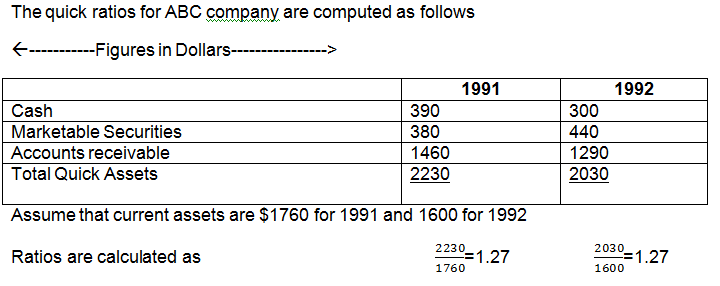
To calculate the current ratio, divide the company’s current assets by its current liabilities. Current assets are those that can be converted into cash within one year, while current liabilities are obligations expected to be paid within one year. Examples of current assets include cash, inventory, and accounts receivable. Examples of current liabilities include accounts payable, wages payable, and the current portion of any scheduled interest or principal payments. Both current assets and current liabilities are listed on a company’s balance sheet. The current ratio is a metric used by accountants and finance professionals to understand a company’s financial health at any given moment.
Trend Analysis – Factors to Consider When Analyzing Current Ratio
- To measure solvency, which is the ability of a business to repay long-term debt and obligations, consider the debt-to-equity ratio.
- Other measures of liquidity and solvency that are similar to the current ratio might be more useful, depending on the situation.
- Some business owners use Excel for accounting, but you can increase productivity and make better decisions using automation.
- This team of experts helps Finance Strategists maintain the highest level of accuracy and professionalism possible.
It’s particularly useful when assessing the short-term financial health of potential investment opportunities. This ratio, however, should not be viewed in isolation but rather as part of a holistic financial analysis. While a high Current Ratio is generally positive, an excessively high ratio may indicate underutilized assets. It’s essential to consider industry norms and the company’s specific circumstances.
What Are Some Ways a Company Can Improve Its Current Ratio?
This is especially true of the retail sector which is dominated by giants such as Wal-Mart and Tesco. Such retailers are also able to keep their own inventory volumes to minimum through efficient supply chain management. The simple intuition that stands behind the current ratio is that the company’s ability to fulfill its obligations depends on the value of its current assets.
Current Liabilities
To compare the current ratio of two companies, it is necessary that both of them use the same inventory valuation method. For example, comparing current ratio of two companies would be like comparing apples with oranges if one uses FIFO while other uses LIFO cost flow assumption for costing/valuing their inventories. The analyst would, therefore, setting up a mobile office for your business not be able to compare the ratio of two companies even in the same industry. As with many other financial metrics, the ideal current ratio will vary depending on the industry, operating model, and business processes of the company in question. These are future expenses that have been paid in advance that haven’t yet been used up or expired.

Interpretation & Analysis
Now that you’ve reviewed the balance sheet accounts in detail, you can start to think about the financial health of your business. Seasonality is normally seen in seasonal commodity-related businesses where raw materials like sugar, wheat, etc., are required. Such purchases are done annually, depending on availability, and are consumed throughout the year. Such purchases require higher investments (generally financed by debt), increasing the current asset side. Companies may attempt to manipulate their current ratio to give investors or lenders a clearer picture of their financial health.
Note that sometimes, the current ratio is also known as the working capital ratio, so don’t be misled by the different names! By reducing its current liabilities, a company can decrease its short-term debt, improving its ability to meet its obligations. For example, a manufacturing company that produces goods may have a lower current ratio than a service-based company that does not have to maintain inventory. For example, let’s say that Company F is looking to obtain a loan from a bank.
The current ratio can provide insight into a company’s operational efficiency. A low current ratio may indicate that a company is not effectively managing its current assets and liabilities. In contrast, a high current ratio may indicate that a company is not investing in future growth opportunities. The current ratio helps investors and stakeholders assess a company’s financial risk by measuring its ability to pay off short-term debts. A low current ratio may indicate a company’s difficulty meeting its short-term obligations, which can be a red flag for investors and stakeholders.
If your business pays a dividend to owners or generates a net loss, equity is decreased. Andy Smith is a Certified Financial Planner (CFP®), licensed realtor and educator with over 35 years of diverse financial management experience. He is an expert on personal finance, corporate finance and real estate and has assisted thousands of clients in meeting their financial goals over his career. Current ratio must be analyzed in the context of the norms of a particular industry. What may be considered normal in one industry may not be considered likewise in another sector. If you are interested in corporate finance, you may also try our other useful calculators.
Companies that focus only on short-term financial health may miss important information about the company’s long-term financial health. For example, a company may have a good current ratio but difficulty remaining competitive long-term without investing in research and development. The current ratio is just one of many financial ratios that should be considered when analyzing a company’s financial health. Companies that focus only on the current ratio may miss important information about the company’s long-term financial health.

